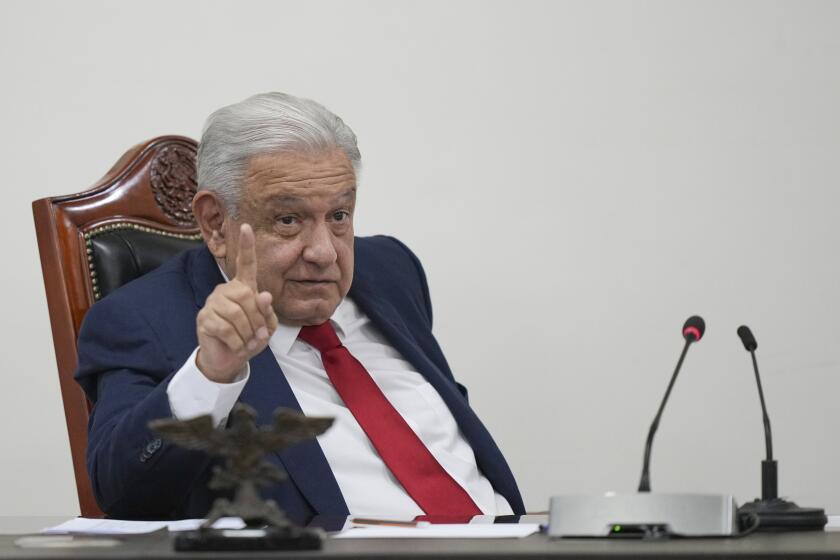No sure bet against swine flu
Don’t count on those disposable masks to protect you against swine flu.
Residents of Mexico City, as well as travelers to and from Los Angeles, have turned to mouth and nose protection of one type or another in recent days in an attempt to stop errant airborne viruses from entering their respiratory tract.
3M, a major producer of face masks and respirators, said that worldwide sales have increased significantly, and some Los Angeles pharmacies have reported selling out of masks. In the drugstore at Tokyo’s Narita International Airport on Monday, mask sales were up 30%. Even recent 99 Cents Only Stores ads touted the devices’ potential to “Prevent the flu!”
Kanna Kanzaki, 36, a resident of Yokohama, Japan, donned a mask before heading to baggage claim this week at Los Angeles International Airport. “I’m very concerned,” she said. She had arrived for a vacation and was taking no chances. “I went to see a doctor this morning and got Tamiflu to prevent the virus.”
Most travelers at the airport were wearing face masks, which are loose-fitting and designed largely to help stop the spread of droplets from the person wearing the mask, not to protect the wearer from the virus. Respirators -- more close-fitting, pricier masks -- are designed to reduce exposure to airborne particles. But there is general uncertainty, even among health professionals, about the value of wearing either during a flu outbreak.
Masks may give people a false sense of security, said Dr. Laurene Mascola, director of acute communicable disease control for the Los Angeles County Department of Public Health.
“You would have to wear it 100% of the time that you are outside,” she said of masks and respirators.
Further, face masks and respirators shouldn’t replace other precautions.
“Somewhat lost in all the excitement is that we continue to need to take standard control measures,” said Dr. Paul Holtom, associate professor of medicine at USC’s Keck School of Medicine and a hospital epidemiologist at Los Angeles County-USC Medical Center and the USC University Hospital.
To avoid infecting others, ill people should stay home, avoid crowds, cover their mouth when they cough or sneeze, and wash their hands before touching eyes, nose or mucus membranes. Those who want to avoid infection should do the same.
According to 3M, standards show how well respirators filter out particles in industrial settings, but there are no established exposure limits for biological agents such as swine flu virus.
The National Institute for Occupational Safety and Health has nine classifications of respirators based on their ability to filter particles. The Centers for Disease Control and Prevention recommends respirators classified as N95 for healthcare workers and caregivers with a respiratory infection.
CDC officials, however, said Monday that they don’t know how helpful either type of covering is in preventing swine flu infection. The best CDC could offer is that, if used correctly, masks and respirators might reduce the risk of getting influenza.
A study published last year in the journal PloS One found that respirators are more efficient than surgical masks at reducing the transmission of respiratory infections to healthy people, but that surgical masks are more efficient than homemade masks.
Another study, published online last week in the journal Risk Analysis, concluded that N95 respirators combined with the use of humidifiers and ventilation in a household improves infection control by 20% to 70%, according to a mathematical model. The authors, from Stanford University, said wearing surgical masks with nylon hosiery or another device to “reduce face-seal leakage” is an alternative if N95 respirators are not available.
But even for people willing to wear such a contraption, there is no single action that will provide complete protection in areas with confirmed swine flu cases, health officials said. It isn’t practical to wear a mask all the time, even a quality mask, and the devices aren’t foolproof.
“Once they get moist, they are no longer useful,” Mascola said. “Your saliva is going to be pooling in that mask. That will make is not useful because germs will be able to permeate.”
Taking a mask on and off contaminates it and makes it less useful, as well. It is effective “only for a 20-minute to a half-hour period,” she said. “Even in those places during the SARS epidemic, they found hand-washing as effective as wearing masks.”
Face masks and respirators are probably most useful for people who are in crowded settings, such as classrooms or airplanes, or people who are in close contact with an infected person. “Close contact” is defined as 3 feet or less by the World Health Organization and 6 feet or less by the U.S. Occupational Safety and Health Administration.
If you want to use a face mask on a crowded plane, though, it’s best to bring your own.
Scott E. Ross said he wanted a face mask when he was leaving San Diego on Sunday for a flight back to his home in Florida. But face masks weren’t provided by airport security or the airline.
After Ross boarded his flight, he noticed that the young man sitting next to him was sweating and coughing. Then the man vomited into an airsickness bag.
“I was rather uncomfortable sitting next to him,” Ross said.
More information on face masks and respirators can be found at www.cdc.gov/ swineflu/masks.htm and other CDC Web pages.
--
ron.lin@latimes.com
More to Read
Sign up for Essential California
The most important California stories and recommendations in your inbox every morning.
You may occasionally receive promotional content from the Los Angeles Times.











